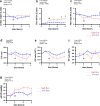A novel experimental porcine model to assess the impact of differential pulmonary blood flow on ischemia-reperfusion injury after unilateral lung transplantation
- PMID: 33543363
- PMCID: PMC7862464
- DOI: 10.1186/s40635-021-00371-1
A novel experimental porcine model to assess the impact of differential pulmonary blood flow on ischemia-reperfusion injury after unilateral lung transplantation
Abstract
Background: Primary graft dysfunction (PGD) remains a major obstacle after lung transplantation. Ischemia-reperfusion injury is a known contributor to the development of PGD following lung transplantation. We developed a novel approach to assess the impact of increased pulmonary blood flow in a large porcine single-left lung transplantation model.
Materials: Twelve porcine left lung transplants were divided in two groups (n = 6, in low- (LF) and high-flow (HF) group). Donor lungs were stored for 24 h on ice, followed by left lung transplantation. In the HF group, recipient animals were observed for 6 h after reperfusion with partially clamping right pulmonary artery to achieve a higher flow (target flow 40-60% of total cardiac output) to the transplanted lung compared to the LF group, where the right pulmonary artery was not clamped.
Results: Survival at 6 h was 100% in both groups. Histological, functional and biological assessment did not significantly differ between both groups during the first 6 h of reperfusion. injury was also present in the right native lung and showed signs compatible with the pathophysiological hallmarks of ischemia-reperfusion injury.
Conclusions: Partial clamping native pulmonary artery in large animal lung transplantation setting to study the impact of low versus high pulmonary flow on the development of ischemia reperfusion is feasible. In our study, differential blood flow had no effect on IRI. However, our findings might impact future studies with extracorporeal devices and represent a specific intra-operative problem during bilateral sequential single-lung transplantation.
Keywords: Porcine left lung transplantation; Primary graft dysfunction; Pulmonary vascular resistance.
Conflict of interest statement
There are no competing interests.
Figures



References
-
- Snell GI, Yusen RD, Weill D, Strueber M, Garrity E, Reed A, et al. Report of the ISHLT Working Group on Primary Lung Graft Dysfunction, part I: Definition and grading-A 2016 Consensus Group statement of the International Society for Heart and Lung Transplantation. J Heart Lung Transplant. 2017;36:1097–1103. doi: 10.1016/j.healun.2017.07.021. - DOI - PubMed
LinkOut - more resources
Full Text Sources
Other Literature Sources
Research Materials
Miscellaneous

